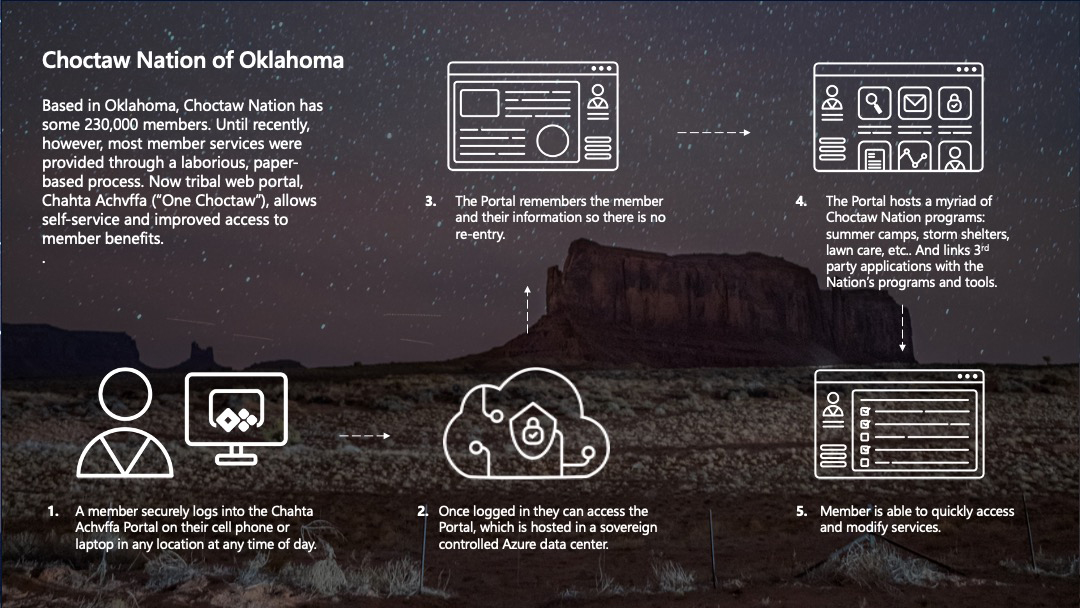Choctaw Nation transforms tribal member services with cloud-based portal
Downloads
Resources
Products
The pains of paper
The Choctaw Nation of Oklahoma sprawls across 10,800 square miles of southeastern Oklahoma. As the third largest federally recognized tribe in the United States, Choctaw Nation has some 230,000 members. Yet only a fraction of that population lives within the reservation. The rest are scattered across the United States and even around the world.
That makes it challenging for Choctaw Nation to deliver tribal services to all its members – at least in a timely fashion. The internal workings of the tribe’s administration were largely manual and paper based.
Choctaw Nation CIO Jimmy Williams, himself a Choctaw member, outlines a frequent problem the tribe faced: “For one service program we’d have 15, 20, 30,000 applications come in via the mail during a funding cycle. Someone would have to open those and type the information into our system. And if anything was missing, they’d have to call that person – if the phone number was legible.”
Through this process, it could take up to two months for a Choctaw member to receive the requested benefit. Now, that has changed.
Operating as One Choctaw
With Williams’ technical oversight, the Choctaw Nation embarked on a mission to modernize and digitize as many of its administrative practices as possible. The result: a web portal – called Chahta Achvffa, or “One Choctaw” – that allows tribal members to access a wide range of services. Information about holiday meal vouchers, high school student services, summer camps, where to shelter in a storm, and more are easily accessed through the self-service portal.
“Now, a tribal member can go to our web portal at night, fill out an application, and it goes into our system,” says Williams. “Unless there is some kind of problem or exception, the request is processed and approved, and the member sees the benefit in a few weeks.”

Always available, 24/7
Choctaw Nation staff members like Deann J. Hawk, an administrator for the tribe’s legal department, also appreciate the change. In her job, Hawk found papers often were lost or misplaced, leading to delays and more work. “For me, the big thing was carrying all my documents around,” says Hawk. “I have three kids, and sometimes I’d go in to apply for services and find I’ve left something at home that I need. It could get frustrating.
Now, with digital access, that’s no longer the case. “If you’re really busy or have to work, the website is available 24 hours a day, so I can go online in the evening and pull up all my kids’ documents. Everything is in one file,” says Hawk.
For Choctaw Nation members, life has become simpler, with fewer administrative headaches. For instance, says Williams, once a member has entered key information such as drivers’ license info, that data stays in the system. So, when a member applies for new services, there’s no need to re-enter it. “We pre-populate your information for you,” he says. “You review it. If it’s correct, you hit ‘submit’ and you’re off to the races.”
In certain instances, it could take up to two months for a member to receive a benefit they qualified for. Now, a tribal member can go to our web portal at night, fill out an application, and it goes into our system. The member sees the benefit in a few weeks.
Delivering quick relief
Choctaw Nation’s new digital backbone also was a boon when Covid-19 struck early in 2020. Choctaw Nation received 140,000 applications for benefits through the Coronavirus Aid, Relief and Economic Security Act.
“If we hadn’t had the platforms and processes in place and had still been typing up applications and hand-writing checks, it would have been a different picture,” Williams says. “Microsoft Azure gave us the opportunity to create a huge ecosystem for the user interface for the member portal. We always worried about the failure points with having our data internally but using Azure for our user interfaces and using a lot of the tools built into Azure for security really helped us move forward quickly.”
Choctaw Nation uses Microsoft SharePoint, Microsoft Power Apps and Microsoft Flow for a variety of transactional and business processes. Still, Williams estimates Choctaw Nation is only about a third of the way through its digital transformation. He is hoping to set up chat bots to answer member questions and develop an even more citizen-centric IT system.
Building a successful future
When Williams joined the Choctaw Nation, the tribe hadn’t created a role for an executive level IT leader and hadn’t invested in its application development capabilities. “It was as grassroots operation – a very small team,” he says. “But we had a strong executive sponsor who believed that a more IT-driven Choctaw Nation would be very powerful for our members.”
Williams has started a pilot program to get more young tribal members interested in working for the Choctaw Nation. The program works with local universities to introduce students to opportunities in IT.
He believes IT will play a substantial role as Choctaw Nation grows and prospers. “We’re heavily invested in our youth,” he says. “Our programs are geared to building young tribal members who are successful, productive people.”
Recommended Videos
Argonne National Laboratory reimagines scientific collaboration during a global pandemic
See how Argonne scientists used mixed reality technology to shift experiments from their labs to their living rooms.
Explore more
Explore our Technology Explainer Video page for overview videos explaining the emerging technology of today, including AI, Machine Learning, and more.
Learn more





